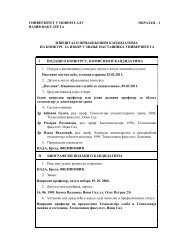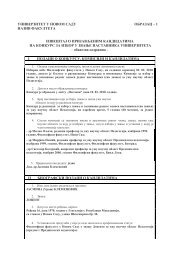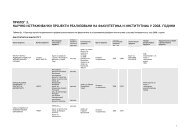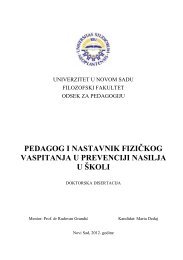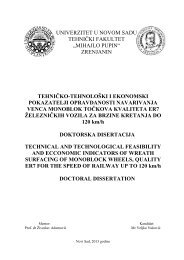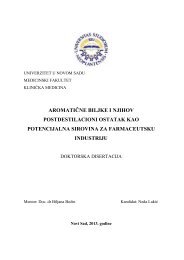Intercultural competence as an aspect of the communicative ...
Intercultural competence as an aspect of the communicative ...
Intercultural competence as an aspect of the communicative ...
Create successful ePaper yourself
Turn your PDF publications into a flip-book with our unique Google optimized e-Paper software.
known practices, <strong>an</strong> individual who is not interculturally competent would not w<strong>an</strong>t to<br />
readjust his/her worldview to include <strong>the</strong> worldview <strong>of</strong> <strong>the</strong> o<strong>the</strong>r <strong>as</strong> valid (Shaules 2007).<br />
These critical incidents that deal with first encounters between people <strong>of</strong> different<br />
cultures showed that our students might not be prepared for <strong>the</strong>m, <strong>an</strong>d that <strong>the</strong>ir first<br />
reaction would be negative, coloured by stereotypes <strong>an</strong>d prejudice <strong>the</strong>y might hold<br />
against those cultures. This is a typical behaviour that would be experienced by <strong>an</strong><br />
individual in <strong>the</strong> Defence stage <strong>of</strong> Bennett’s model (1993), where cultural differences are<br />
indeed perceived <strong>as</strong> a threat <strong>an</strong>d usually experienced <strong>as</strong> stereotypes. Also, in terms <strong>of</strong><br />
Byram’s model, <strong>the</strong>se attitudes would point to a certain lack in all five types <strong>of</strong> saviors.<br />
The une<strong>as</strong>e that <strong>the</strong> interviewees mentioned is in contr<strong>as</strong>t with <strong>the</strong> GPI results,<br />
since <strong>the</strong>re <strong>the</strong> categories where <strong>the</strong> students scored highest were Global citizenship <strong>an</strong>d<br />
Identity (3.7 <strong>an</strong>d 3.9 respectively). These categories contain ide<strong>as</strong> such <strong>as</strong> being able to<br />
recognize culture differences <strong>an</strong>d discuss <strong>the</strong>m, or being able to perform different social<br />
roles, <strong>an</strong>d show that what students perceived <strong>as</strong> <strong>the</strong>ir <strong>competence</strong> w<strong>as</strong> not sufficient for<br />
<strong>the</strong>m to navigate <strong>the</strong> first encounter.<br />
The data show that <strong>the</strong>re w<strong>as</strong> not <strong>an</strong>y particular difference between <strong>the</strong> English<br />
l<strong>an</strong>guage students <strong>an</strong>d students from o<strong>the</strong>r departments. In this particular c<strong>as</strong>e, even<br />
though one <strong>of</strong> <strong>the</strong> interviewees w<strong>as</strong> from <strong>the</strong> English Department who had had first-h<strong>an</strong>d<br />
experience with a foreign culture, she still had problems finding a correct attribution <strong>an</strong>d<br />
recognizing <strong>the</strong> possible cultural elements at play in critical incidents. Compared with <strong>the</strong><br />
GPI results, it could be seen that <strong>the</strong> me<strong>an</strong> scores for <strong>the</strong>se two categories – Global<br />
citizenship <strong>an</strong>d Identity were a bit lower th<strong>an</strong> <strong>the</strong> average for all students (3.5 <strong>an</strong>d 3.8<br />
respectively).<br />
These first two incidents proved what Byram states, that attitudes learners have<br />
‘towards people who are perceived <strong>as</strong> different in respect <strong>of</strong> <strong>the</strong> cultural me<strong>an</strong>ings, beliefs<br />
<strong>an</strong>d behaviours <strong>the</strong>y exhibit’ (Byram 1997: 34) are usually stereotypical <strong>an</strong>d b<strong>as</strong>ed on<br />
prejudice. While <strong>the</strong>se need not be always negative, Byram stresses that that c<strong>an</strong>not be<br />
enough <strong>as</strong> a pre-condition for a successful IC interaction, <strong>the</strong>se attitudes should be b<strong>as</strong>ed<br />
on curiosity, openness <strong>an</strong>d ‘suspension <strong>of</strong> disbelief <strong>an</strong>d judgement’ (ibid).<br />
Ano<strong>the</strong>r point that could be made is that since knowledge about <strong>an</strong>o<strong>the</strong>r culture is<br />
relational it does not provide a sound b<strong>as</strong>e for ‘<strong>the</strong> second category <strong>of</strong> knowledge:<br />
knowledge <strong>of</strong> processes <strong>of</strong> interaction’ (Byram 1997: 36) in that culture on both<br />
individual <strong>an</strong>d societal levels. This second knowledge would become instrumental in<br />
encounters <strong>an</strong>d would help <strong>an</strong> individual act correctly. Both attitudes <strong>an</strong>d knowledge play<br />
210



